Professional HRM Practices and Strategic Change at Bank A
VerifiedAdded on 2022/09/30
|14
|3757
|4
Essay
AI Summary
This essay, written for the CEO of Bank A, a Malaysian company, delves into professional Human Resource Management (HRM) practices and their significance in a changing organizational landscape. It explores the critical role of HRM in adapting to strategic changes, aligning HRM with organizational goals, and the impact of technology on HRM practices. The essay examines the importance of HRM in a changing world, focusing on employee retention, company culture, and the collaboration between digital tools and human resources. It further discusses the alignment of HRM with organizational strategy, emphasizing the need for proper training and development to anticipate changes in job roles. The essay also highlights how technology is reshaping HRM, making it more efficient in areas like employee communication and data analysis. Overall, the essay offers a detailed analysis of HRM's role in driving organizational success, particularly in the context of Bank A's strategic objectives and challenges. The essay also mentions about the need of implementing change in the bank for profit making.
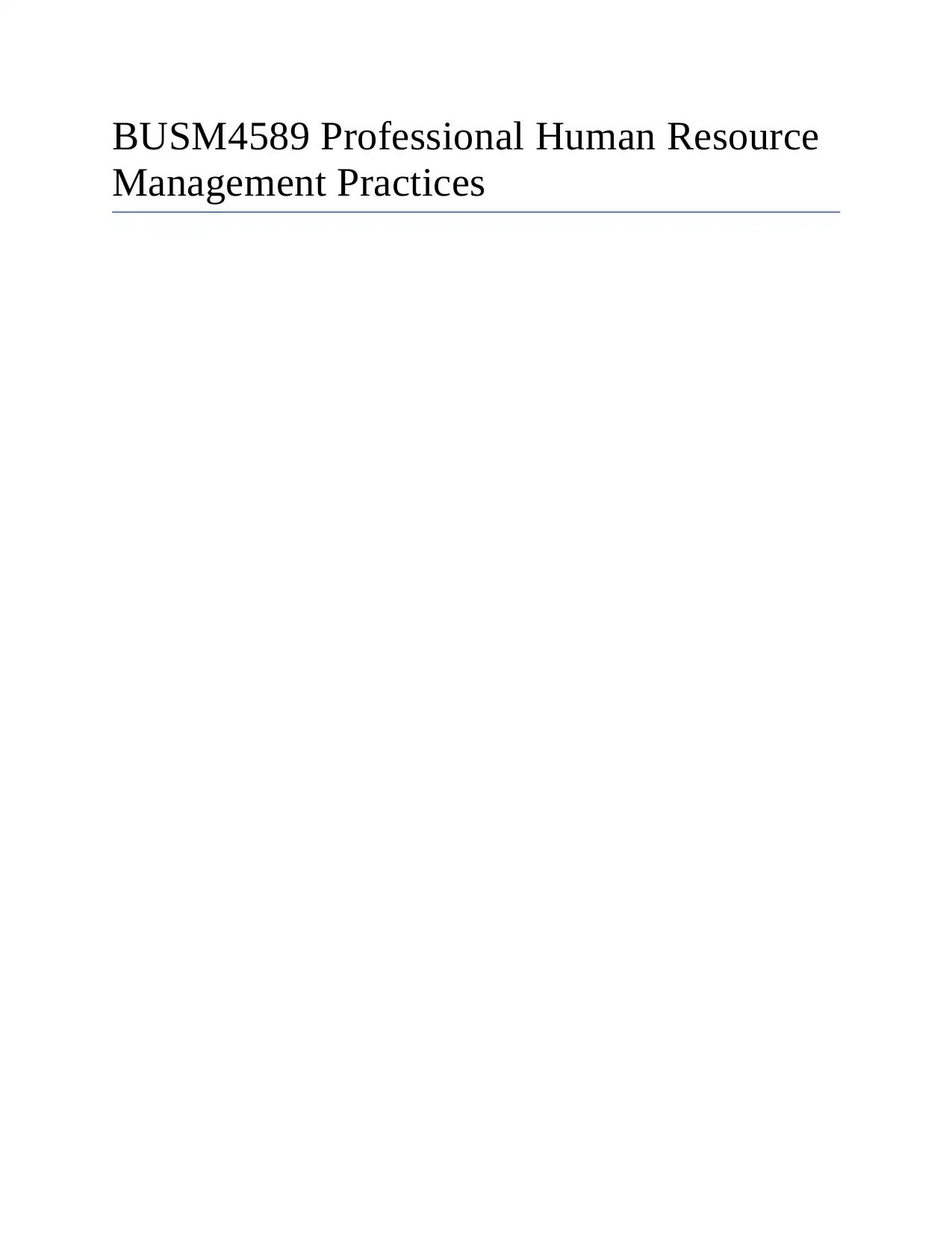
BUSM4589 Professional Human Resource
Management Practices
Management Practices
Paraphrase This Document
Need a fresh take? Get an instant paraphrase of this document with our AI Paraphraser
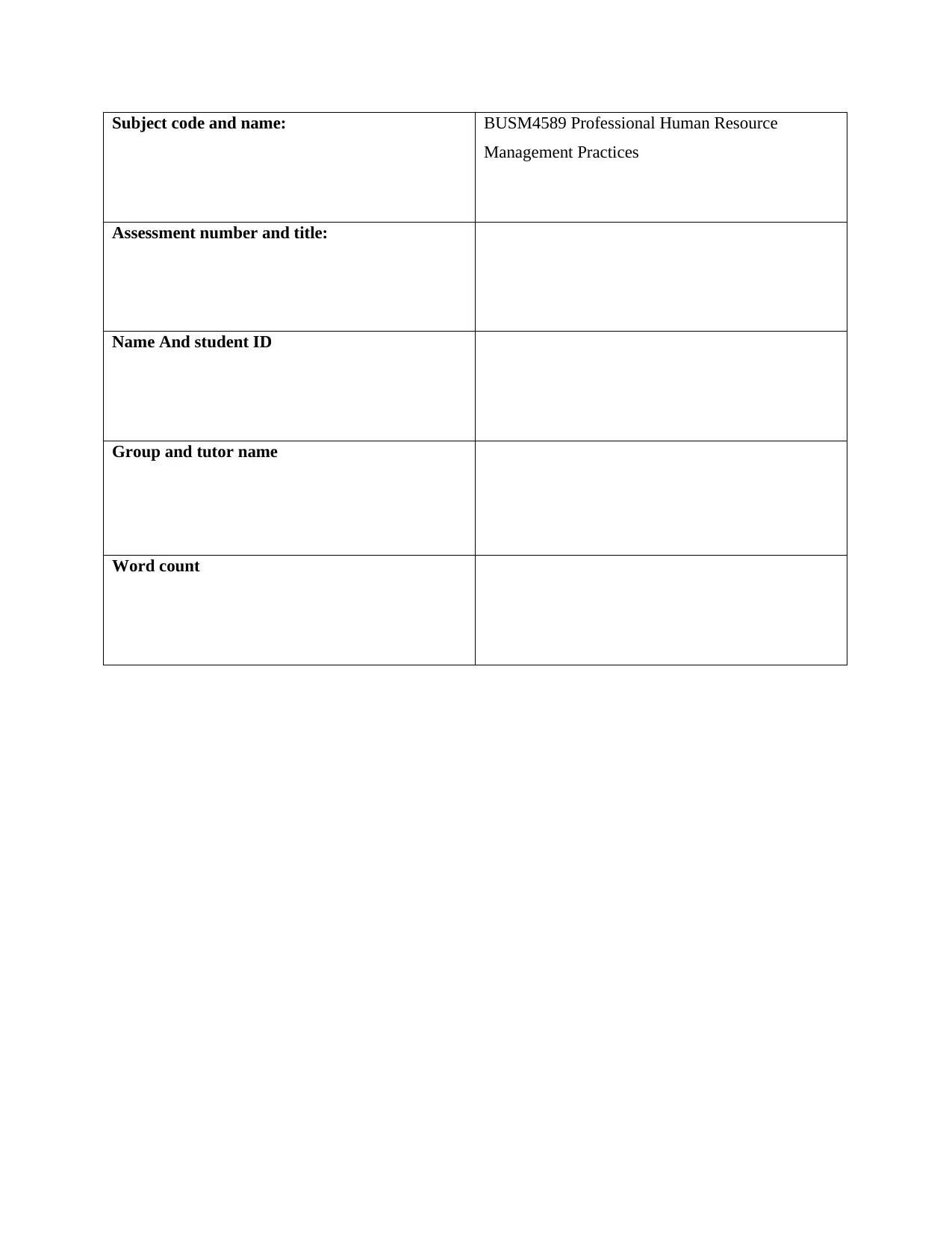
Subject code and name: BUSM4589 Professional Human Resource
Management Practices
Assessment number and title:
Name And student ID
Group and tutor name
Word count
Management Practices
Assessment number and title:
Name And student ID
Group and tutor name
Word count
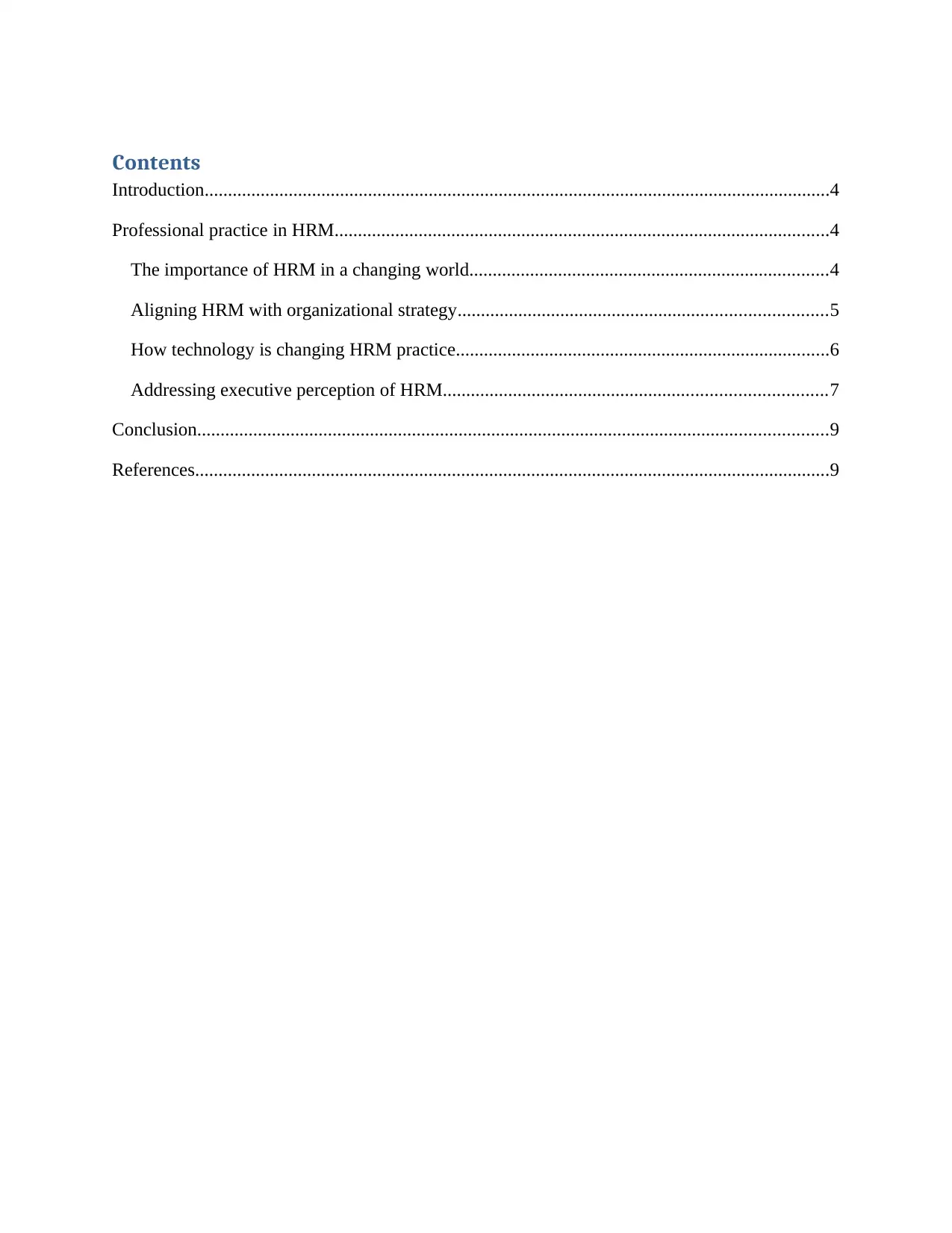
Contents
Introduction......................................................................................................................................4
Professional practice in HRM..........................................................................................................4
The importance of HRM in a changing world.............................................................................4
Aligning HRM with organizational strategy...............................................................................5
How technology is changing HRM practice................................................................................6
Addressing executive perception of HRM..................................................................................7
Conclusion.......................................................................................................................................9
References........................................................................................................................................9
Introduction......................................................................................................................................4
Professional practice in HRM..........................................................................................................4
The importance of HRM in a changing world.............................................................................4
Aligning HRM with organizational strategy...............................................................................5
How technology is changing HRM practice................................................................................6
Addressing executive perception of HRM..................................................................................7
Conclusion.......................................................................................................................................9
References........................................................................................................................................9
⊘ This is a preview!⊘
Do you want full access?
Subscribe today to unlock all pages.

Trusted by 1+ million students worldwide
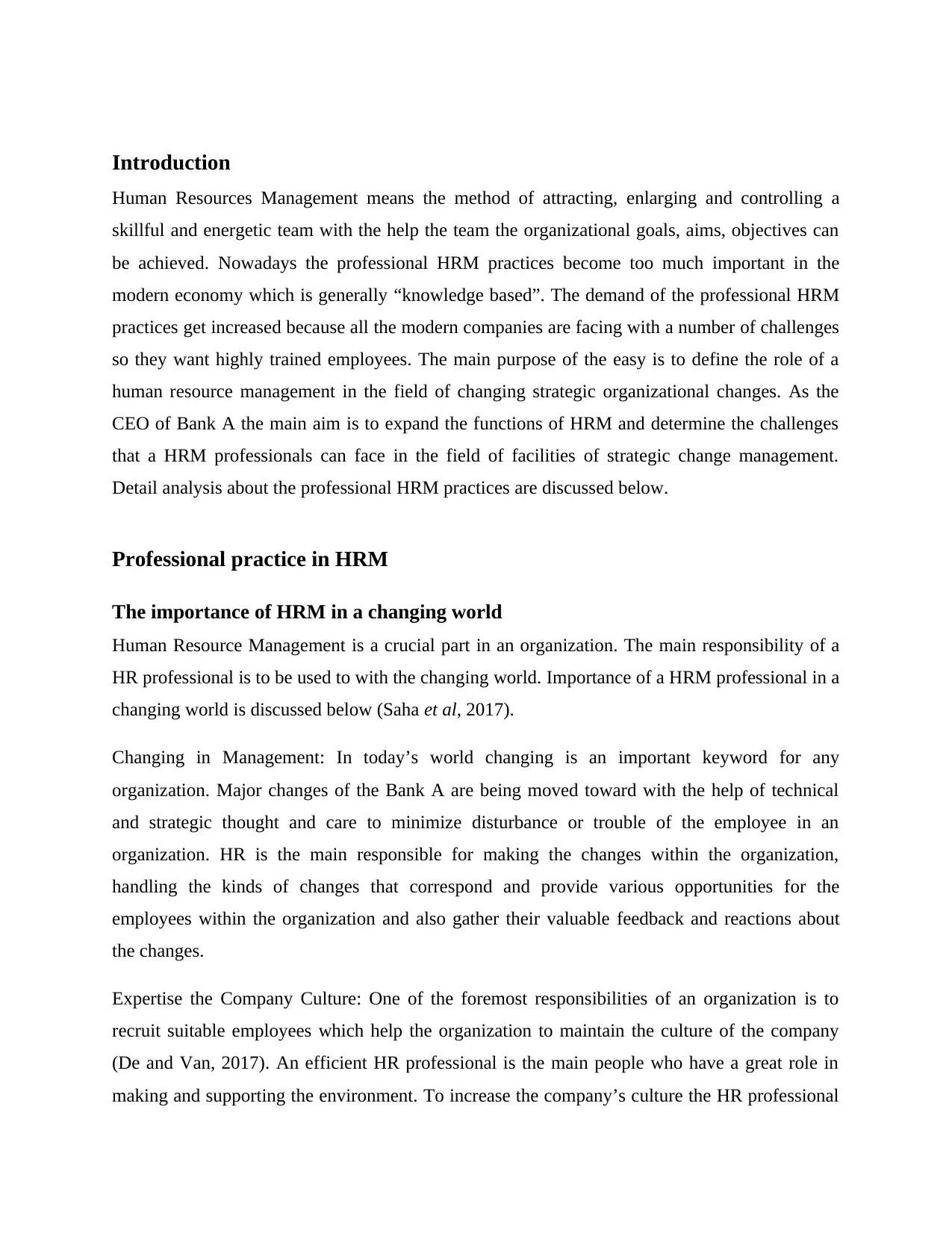
Introduction
Human Resources Management means the method of attracting, enlarging and controlling a
skillful and energetic team with the help the team the organizational goals, aims, objectives can
be achieved. Nowadays the professional HRM practices become too much important in the
modern economy which is generally “knowledge based”. The demand of the professional HRM
practices get increased because all the modern companies are facing with a number of challenges
so they want highly trained employees. The main purpose of the easy is to define the role of a
human resource management in the field of changing strategic organizational changes. As the
CEO of Bank A the main aim is to expand the functions of HRM and determine the challenges
that a HRM professionals can face in the field of facilities of strategic change management.
Detail analysis about the professional HRM practices are discussed below.
Professional practice in HRM
The importance of HRM in a changing world
Human Resource Management is a crucial part in an organization. The main responsibility of a
HR professional is to be used to with the changing world. Importance of a HRM professional in a
changing world is discussed below (Saha et al, 2017).
Changing in Management: In today’s world changing is an important keyword for any
organization. Major changes of the Bank A are being moved toward with the help of technical
and strategic thought and care to minimize disturbance or trouble of the employee in an
organization. HR is the main responsible for making the changes within the organization,
handling the kinds of changes that correspond and provide various opportunities for the
employees within the organization and also gather their valuable feedback and reactions about
the changes.
Expertise the Company Culture: One of the foremost responsibilities of an organization is to
recruit suitable employees which help the organization to maintain the culture of the company
(De and Van, 2017). An efficient HR professional is the main people who have a great role in
making and supporting the environment. To increase the company’s culture the HR professional
Human Resources Management means the method of attracting, enlarging and controlling a
skillful and energetic team with the help the team the organizational goals, aims, objectives can
be achieved. Nowadays the professional HRM practices become too much important in the
modern economy which is generally “knowledge based”. The demand of the professional HRM
practices get increased because all the modern companies are facing with a number of challenges
so they want highly trained employees. The main purpose of the easy is to define the role of a
human resource management in the field of changing strategic organizational changes. As the
CEO of Bank A the main aim is to expand the functions of HRM and determine the challenges
that a HRM professionals can face in the field of facilities of strategic change management.
Detail analysis about the professional HRM practices are discussed below.
Professional practice in HRM
The importance of HRM in a changing world
Human Resource Management is a crucial part in an organization. The main responsibility of a
HR professional is to be used to with the changing world. Importance of a HRM professional in a
changing world is discussed below (Saha et al, 2017).
Changing in Management: In today’s world changing is an important keyword for any
organization. Major changes of the Bank A are being moved toward with the help of technical
and strategic thought and care to minimize disturbance or trouble of the employee in an
organization. HR is the main responsible for making the changes within the organization,
handling the kinds of changes that correspond and provide various opportunities for the
employees within the organization and also gather their valuable feedback and reactions about
the changes.
Expertise the Company Culture: One of the foremost responsibilities of an organization is to
recruit suitable employees which help the organization to maintain the culture of the company
(De and Van, 2017). An efficient HR professional is the main people who have a great role in
making and supporting the environment. To increase the company’s culture the HR professional
Paraphrase This Document
Need a fresh take? Get an instant paraphrase of this document with our AI Paraphraser
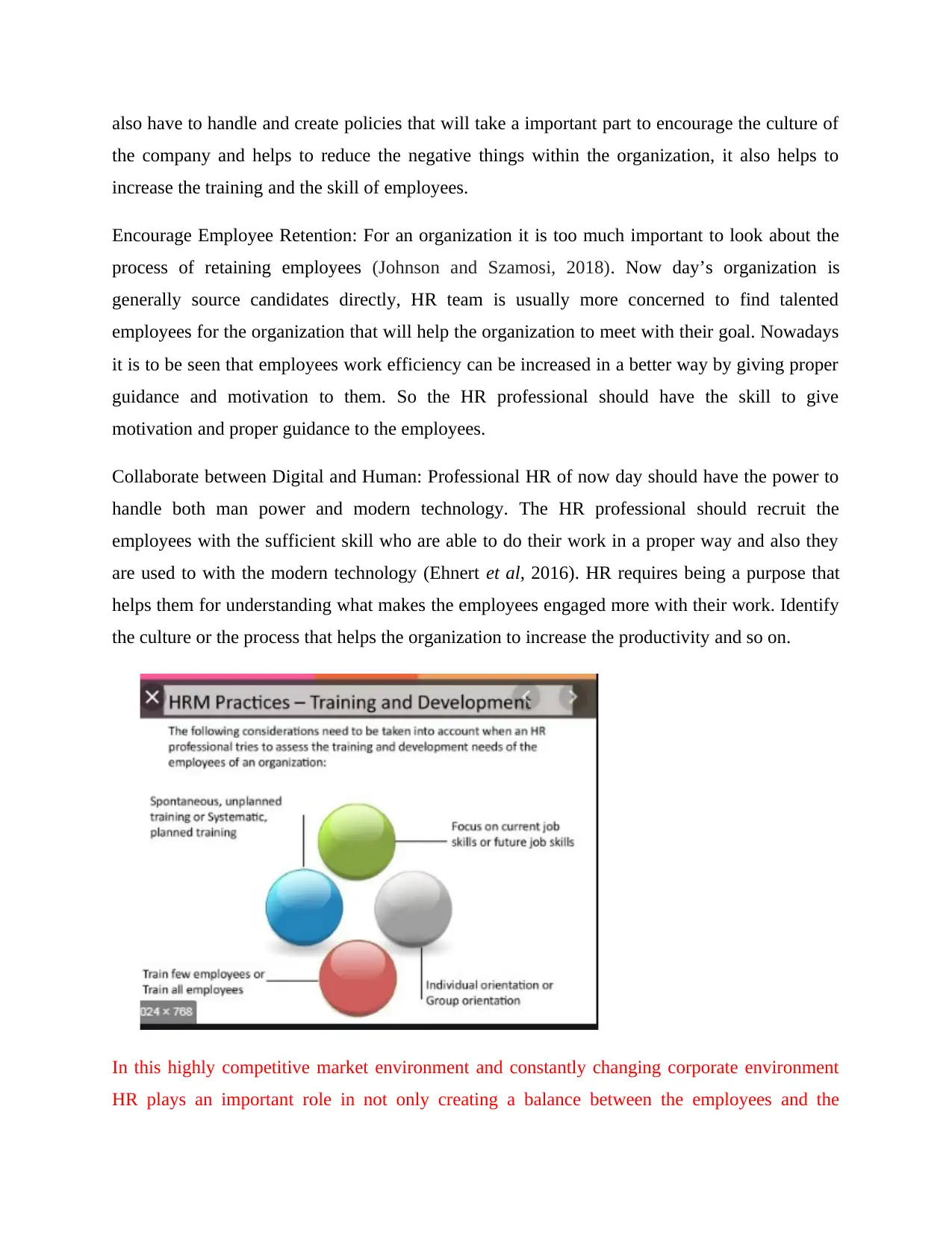
also have to handle and create policies that will take a important part to encourage the culture of
the company and helps to reduce the negative things within the organization, it also helps to
increase the training and the skill of employees.
Encourage Employee Retention: For an organization it is too much important to look about the
process of retaining employees (Johnson and Szamosi, 2018). Now day’s organization is
generally source candidates directly, HR team is usually more concerned to find talented
employees for the organization that will help the organization to meet with their goal. Nowadays
it is to be seen that employees work efficiency can be increased in a better way by giving proper
guidance and motivation to them. So the HR professional should have the skill to give
motivation and proper guidance to the employees.
Collaborate between Digital and Human: Professional HR of now day should have the power to
handle both man power and modern technology. The HR professional should recruit the
employees with the sufficient skill who are able to do their work in a proper way and also they
are used to with the modern technology (Ehnert et al, 2016). HR requires being a purpose that
helps them for understanding what makes the employees engaged more with their work. Identify
the culture or the process that helps the organization to increase the productivity and so on.
In this highly competitive market environment and constantly changing corporate environment
HR plays an important role in not only creating a balance between the employees and the
the company and helps to reduce the negative things within the organization, it also helps to
increase the training and the skill of employees.
Encourage Employee Retention: For an organization it is too much important to look about the
process of retaining employees (Johnson and Szamosi, 2018). Now day’s organization is
generally source candidates directly, HR team is usually more concerned to find talented
employees for the organization that will help the organization to meet with their goal. Nowadays
it is to be seen that employees work efficiency can be increased in a better way by giving proper
guidance and motivation to them. So the HR professional should have the skill to give
motivation and proper guidance to the employees.
Collaborate between Digital and Human: Professional HR of now day should have the power to
handle both man power and modern technology. The HR professional should recruit the
employees with the sufficient skill who are able to do their work in a proper way and also they
are used to with the modern technology (Ehnert et al, 2016). HR requires being a purpose that
helps them for understanding what makes the employees engaged more with their work. Identify
the culture or the process that helps the organization to increase the productivity and so on.
In this highly competitive market environment and constantly changing corporate environment
HR plays an important role in not only creating a balance between the employees and the
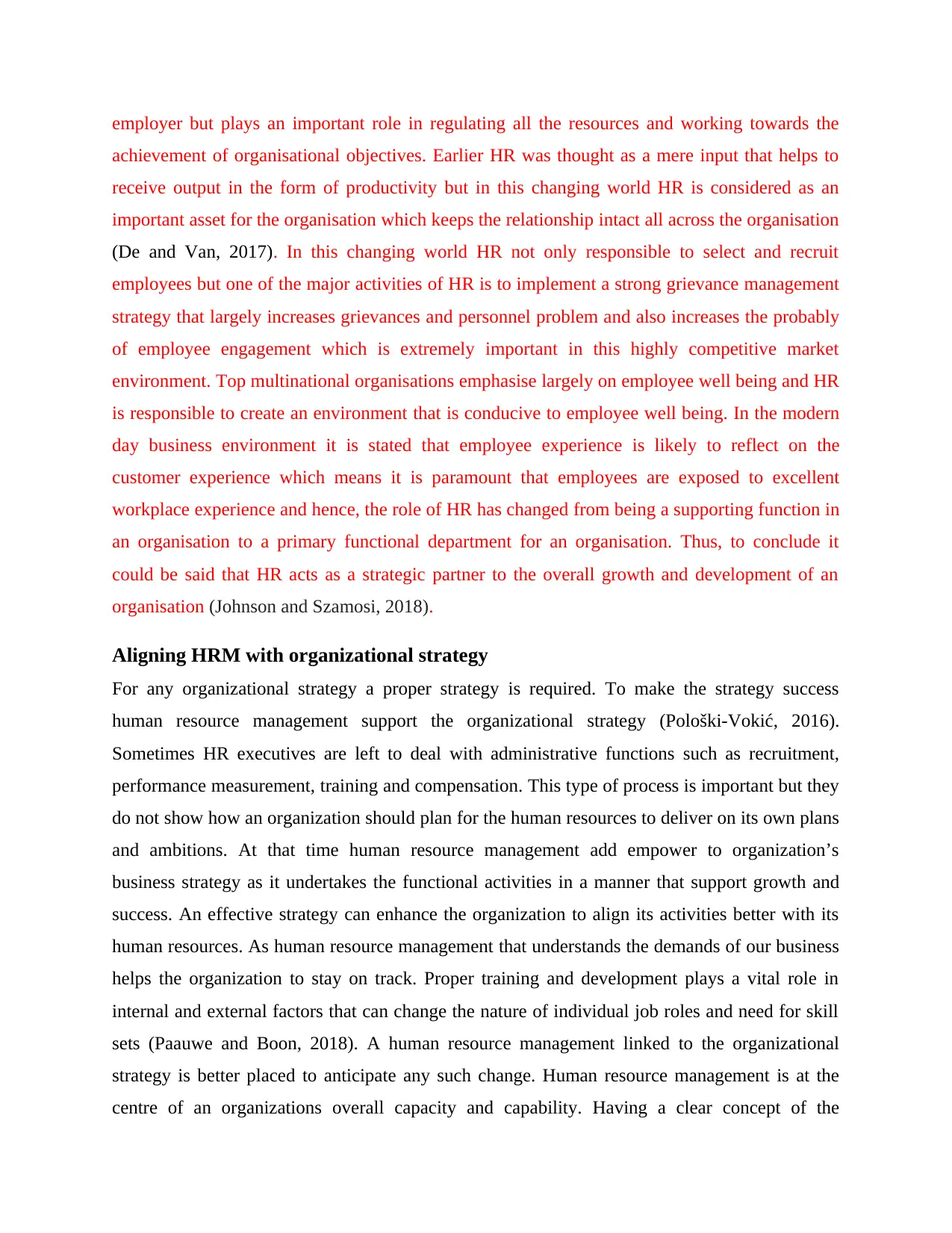
employer but plays an important role in regulating all the resources and working towards the
achievement of organisational objectives. Earlier HR was thought as a mere input that helps to
receive output in the form of productivity but in this changing world HR is considered as an
important asset for the organisation which keeps the relationship intact all across the organisation
(De and Van, 2017). In this changing world HR not only responsible to select and recruit
employees but one of the major activities of HR is to implement a strong grievance management
strategy that largely increases grievances and personnel problem and also increases the probably
of employee engagement which is extremely important in this highly competitive market
environment. Top multinational organisations emphasise largely on employee well being and HR
is responsible to create an environment that is conducive to employee well being. In the modern
day business environment it is stated that employee experience is likely to reflect on the
customer experience which means it is paramount that employees are exposed to excellent
workplace experience and hence, the role of HR has changed from being a supporting function in
an organisation to a primary functional department for an organisation. Thus, to conclude it
could be said that HR acts as a strategic partner to the overall growth and development of an
organisation (Johnson and Szamosi, 2018).
Aligning HRM with organizational strategy
For any organizational strategy a proper strategy is required. To make the strategy success
human resource management support the organizational strategy (Pološki-Vokić, 2016).
Sometimes HR executives are left to deal with administrative functions such as recruitment,
performance measurement, training and compensation. This type of process is important but they
do not show how an organization should plan for the human resources to deliver on its own plans
and ambitions. At that time human resource management add empower to organization’s
business strategy as it undertakes the functional activities in a manner that support growth and
success. An effective strategy can enhance the organization to align its activities better with its
human resources. As human resource management that understands the demands of our business
helps the organization to stay on track. Proper training and development plays a vital role in
internal and external factors that can change the nature of individual job roles and need for skill
sets (Paauwe and Boon, 2018). A human resource management linked to the organizational
strategy is better placed to anticipate any such change. Human resource management is at the
centre of an organizations overall capacity and capability. Having a clear concept of the
achievement of organisational objectives. Earlier HR was thought as a mere input that helps to
receive output in the form of productivity but in this changing world HR is considered as an
important asset for the organisation which keeps the relationship intact all across the organisation
(De and Van, 2017). In this changing world HR not only responsible to select and recruit
employees but one of the major activities of HR is to implement a strong grievance management
strategy that largely increases grievances and personnel problem and also increases the probably
of employee engagement which is extremely important in this highly competitive market
environment. Top multinational organisations emphasise largely on employee well being and HR
is responsible to create an environment that is conducive to employee well being. In the modern
day business environment it is stated that employee experience is likely to reflect on the
customer experience which means it is paramount that employees are exposed to excellent
workplace experience and hence, the role of HR has changed from being a supporting function in
an organisation to a primary functional department for an organisation. Thus, to conclude it
could be said that HR acts as a strategic partner to the overall growth and development of an
organisation (Johnson and Szamosi, 2018).
Aligning HRM with organizational strategy
For any organizational strategy a proper strategy is required. To make the strategy success
human resource management support the organizational strategy (Pološki-Vokić, 2016).
Sometimes HR executives are left to deal with administrative functions such as recruitment,
performance measurement, training and compensation. This type of process is important but they
do not show how an organization should plan for the human resources to deliver on its own plans
and ambitions. At that time human resource management add empower to organization’s
business strategy as it undertakes the functional activities in a manner that support growth and
success. An effective strategy can enhance the organization to align its activities better with its
human resources. As human resource management that understands the demands of our business
helps the organization to stay on track. Proper training and development plays a vital role in
internal and external factors that can change the nature of individual job roles and need for skill
sets (Paauwe and Boon, 2018). A human resource management linked to the organizational
strategy is better placed to anticipate any such change. Human resource management is at the
centre of an organizations overall capacity and capability. Having a clear concept of the
⊘ This is a preview!⊘
Do you want full access?
Subscribe today to unlock all pages.

Trusted by 1+ million students worldwide
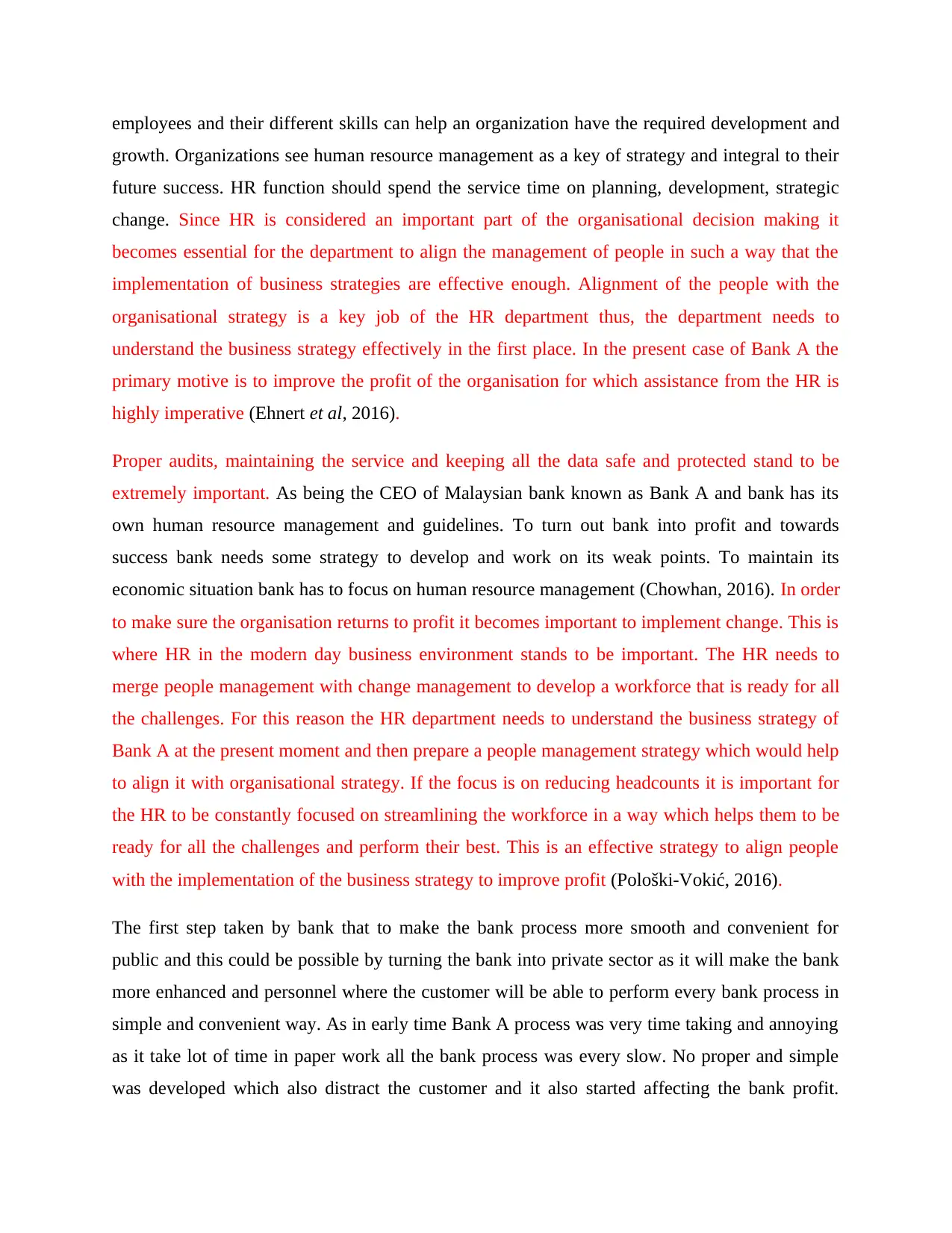
employees and their different skills can help an organization have the required development and
growth. Organizations see human resource management as a key of strategy and integral to their
future success. HR function should spend the service time on planning, development, strategic
change. Since HR is considered an important part of the organisational decision making it
becomes essential for the department to align the management of people in such a way that the
implementation of business strategies are effective enough. Alignment of the people with the
organisational strategy is a key job of the HR department thus, the department needs to
understand the business strategy effectively in the first place. In the present case of Bank A the
primary motive is to improve the profit of the organisation for which assistance from the HR is
highly imperative (Ehnert et al, 2016).
Proper audits, maintaining the service and keeping all the data safe and protected stand to be
extremely important. As being the CEO of Malaysian bank known as Bank A and bank has its
own human resource management and guidelines. To turn out bank into profit and towards
success bank needs some strategy to develop and work on its weak points. To maintain its
economic situation bank has to focus on human resource management (Chowhan, 2016). In order
to make sure the organisation returns to profit it becomes important to implement change. This is
where HR in the modern day business environment stands to be important. The HR needs to
merge people management with change management to develop a workforce that is ready for all
the challenges. For this reason the HR department needs to understand the business strategy of
Bank A at the present moment and then prepare a people management strategy which would help
to align it with organisational strategy. If the focus is on reducing headcounts it is important for
the HR to be constantly focused on streamlining the workforce in a way which helps them to be
ready for all the challenges and perform their best. This is an effective strategy to align people
with the implementation of the business strategy to improve profit (Pološki-Vokić, 2016).
The first step taken by bank that to make the bank process more smooth and convenient for
public and this could be possible by turning the bank into private sector as it will make the bank
more enhanced and personnel where the customer will be able to perform every bank process in
simple and convenient way. As in early time Bank A process was very time taking and annoying
as it take lot of time in paper work all the bank process was every slow. No proper and simple
was developed which also distract the customer and it also started affecting the bank profit.
growth. Organizations see human resource management as a key of strategy and integral to their
future success. HR function should spend the service time on planning, development, strategic
change. Since HR is considered an important part of the organisational decision making it
becomes essential for the department to align the management of people in such a way that the
implementation of business strategies are effective enough. Alignment of the people with the
organisational strategy is a key job of the HR department thus, the department needs to
understand the business strategy effectively in the first place. In the present case of Bank A the
primary motive is to improve the profit of the organisation for which assistance from the HR is
highly imperative (Ehnert et al, 2016).
Proper audits, maintaining the service and keeping all the data safe and protected stand to be
extremely important. As being the CEO of Malaysian bank known as Bank A and bank has its
own human resource management and guidelines. To turn out bank into profit and towards
success bank needs some strategy to develop and work on its weak points. To maintain its
economic situation bank has to focus on human resource management (Chowhan, 2016). In order
to make sure the organisation returns to profit it becomes important to implement change. This is
where HR in the modern day business environment stands to be important. The HR needs to
merge people management with change management to develop a workforce that is ready for all
the challenges. For this reason the HR department needs to understand the business strategy of
Bank A at the present moment and then prepare a people management strategy which would help
to align it with organisational strategy. If the focus is on reducing headcounts it is important for
the HR to be constantly focused on streamlining the workforce in a way which helps them to be
ready for all the challenges and perform their best. This is an effective strategy to align people
with the implementation of the business strategy to improve profit (Pološki-Vokić, 2016).
The first step taken by bank that to make the bank process more smooth and convenient for
public and this could be possible by turning the bank into private sector as it will make the bank
more enhanced and personnel where the customer will be able to perform every bank process in
simple and convenient way. As in early time Bank A process was very time taking and annoying
as it take lot of time in paper work all the bank process was every slow. No proper and simple
was developed which also distract the customer and it also started affecting the bank profit.
Paraphrase This Document
Need a fresh take? Get an instant paraphrase of this document with our AI Paraphraser

Aligning with human resource management it gives a change in banking sector by the support of
this bank process was totally changed. Most of the paper works has been removed and has been
turned digitally (L’Écuyer and Raymond, 2017). Changing into personal banking gives more
space to the customers and it also attracts them towards the bank.
How technology is changing HRM practice
Everywhere around the whole world there is a impact of technology. Technology changes the
way of working, it provides a way to Human resource department that how to contact employees,
stores data and files, analyze employees performance (Bowen, 2016). Using good technology
makes the Human resource work more efficient. Proper way of Human resource practice gives a
good profit benefits and also minimize the problems. Technology makes it easier to gather and
breakdown data on employees to get an overall picture. When there was no technology such as
use of internet and email then it was very difficult for the job seekers to give their interview. If
the company was in another city then they have to go there for the interview but during this
technology it changes everything around (Marler and Parry, 2016). Now we can give online
interview across the globe through internet, we share any data and information regarding
whatever subject through email. This is the impact of technology which changes everyone life
this bank process was totally changed. Most of the paper works has been removed and has been
turned digitally (L’Écuyer and Raymond, 2017). Changing into personal banking gives more
space to the customers and it also attracts them towards the bank.
How technology is changing HRM practice
Everywhere around the whole world there is a impact of technology. Technology changes the
way of working, it provides a way to Human resource department that how to contact employees,
stores data and files, analyze employees performance (Bowen, 2016). Using good technology
makes the Human resource work more efficient. Proper way of Human resource practice gives a
good profit benefits and also minimize the problems. Technology makes it easier to gather and
breakdown data on employees to get an overall picture. When there was no technology such as
use of internet and email then it was very difficult for the job seekers to give their interview. If
the company was in another city then they have to go there for the interview but during this
technology it changes everything around (Marler and Parry, 2016). Now we can give online
interview across the globe through internet, we share any data and information regarding
whatever subject through email. This is the impact of technology which changes everyone life
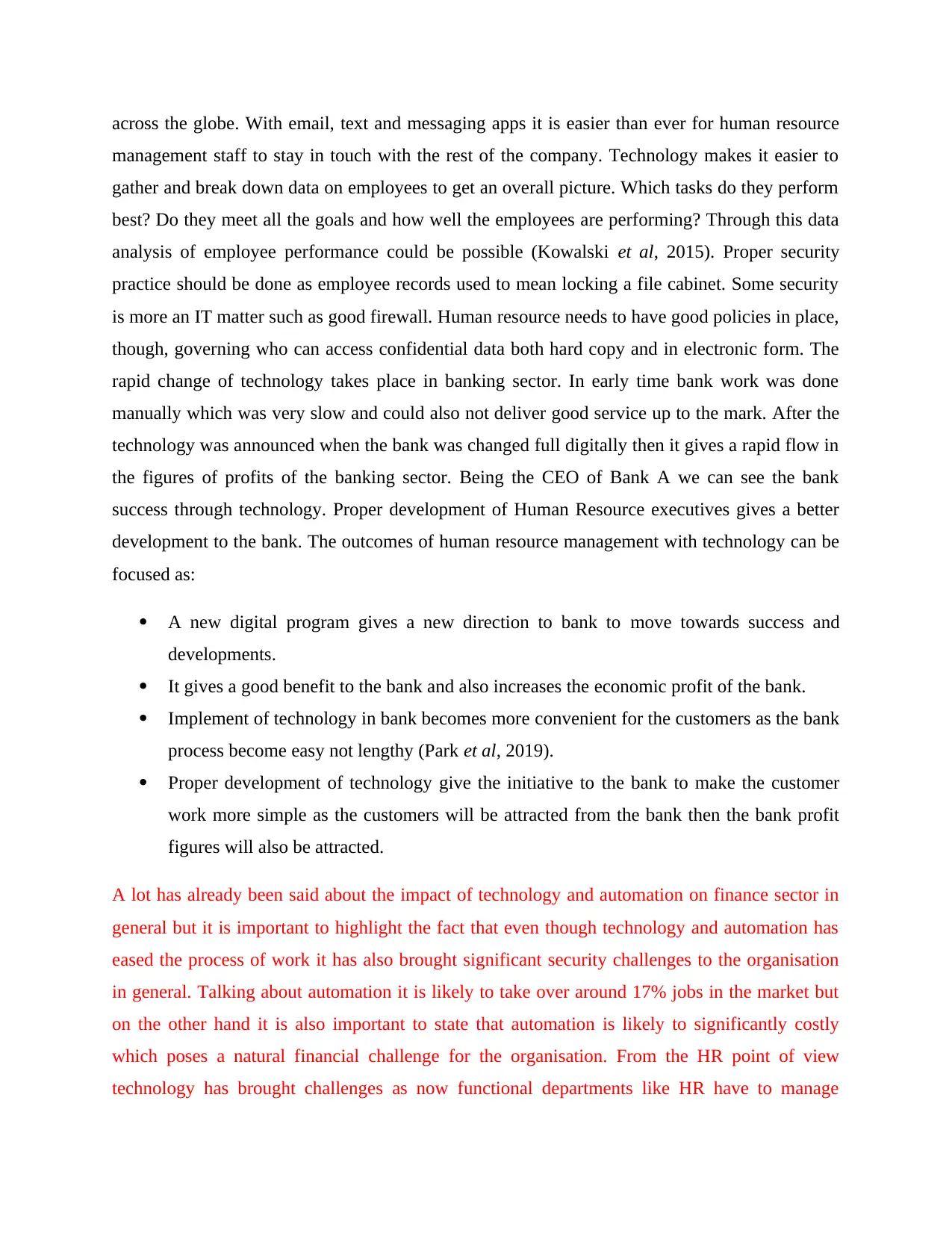
across the globe. With email, text and messaging apps it is easier than ever for human resource
management staff to stay in touch with the rest of the company. Technology makes it easier to
gather and break down data on employees to get an overall picture. Which tasks do they perform
best? Do they meet all the goals and how well the employees are performing? Through this data
analysis of employee performance could be possible (Kowalski et al, 2015). Proper security
practice should be done as employee records used to mean locking a file cabinet. Some security
is more an IT matter such as good firewall. Human resource needs to have good policies in place,
though, governing who can access confidential data both hard copy and in electronic form. The
rapid change of technology takes place in banking sector. In early time bank work was done
manually which was very slow and could also not deliver good service up to the mark. After the
technology was announced when the bank was changed full digitally then it gives a rapid flow in
the figures of profits of the banking sector. Being the CEO of Bank A we can see the bank
success through technology. Proper development of Human Resource executives gives a better
development to the bank. The outcomes of human resource management with technology can be
focused as:
A new digital program gives a new direction to bank to move towards success and
developments.
It gives a good benefit to the bank and also increases the economic profit of the bank.
Implement of technology in bank becomes more convenient for the customers as the bank
process become easy not lengthy (Park et al, 2019).
Proper development of technology give the initiative to the bank to make the customer
work more simple as the customers will be attracted from the bank then the bank profit
figures will also be attracted.
A lot has already been said about the impact of technology and automation on finance sector in
general but it is important to highlight the fact that even though technology and automation has
eased the process of work it has also brought significant security challenges to the organisation
in general. Talking about automation it is likely to take over around 17% jobs in the market but
on the other hand it is also important to state that automation is likely to significantly costly
which poses a natural financial challenge for the organisation. From the HR point of view
technology has brought challenges as now functional departments like HR have to manage
management staff to stay in touch with the rest of the company. Technology makes it easier to
gather and break down data on employees to get an overall picture. Which tasks do they perform
best? Do they meet all the goals and how well the employees are performing? Through this data
analysis of employee performance could be possible (Kowalski et al, 2015). Proper security
practice should be done as employee records used to mean locking a file cabinet. Some security
is more an IT matter such as good firewall. Human resource needs to have good policies in place,
though, governing who can access confidential data both hard copy and in electronic form. The
rapid change of technology takes place in banking sector. In early time bank work was done
manually which was very slow and could also not deliver good service up to the mark. After the
technology was announced when the bank was changed full digitally then it gives a rapid flow in
the figures of profits of the banking sector. Being the CEO of Bank A we can see the bank
success through technology. Proper development of Human Resource executives gives a better
development to the bank. The outcomes of human resource management with technology can be
focused as:
A new digital program gives a new direction to bank to move towards success and
developments.
It gives a good benefit to the bank and also increases the economic profit of the bank.
Implement of technology in bank becomes more convenient for the customers as the bank
process become easy not lengthy (Park et al, 2019).
Proper development of technology give the initiative to the bank to make the customer
work more simple as the customers will be attracted from the bank then the bank profit
figures will also be attracted.
A lot has already been said about the impact of technology and automation on finance sector in
general but it is important to highlight the fact that even though technology and automation has
eased the process of work it has also brought significant security challenges to the organisation
in general. Talking about automation it is likely to take over around 17% jobs in the market but
on the other hand it is also important to state that automation is likely to significantly costly
which poses a natural financial challenge for the organisation. From the HR point of view
technology has brought challenges as now functional departments like HR have to manage
⊘ This is a preview!⊘
Do you want full access?
Subscribe today to unlock all pages.

Trusted by 1+ million students worldwide
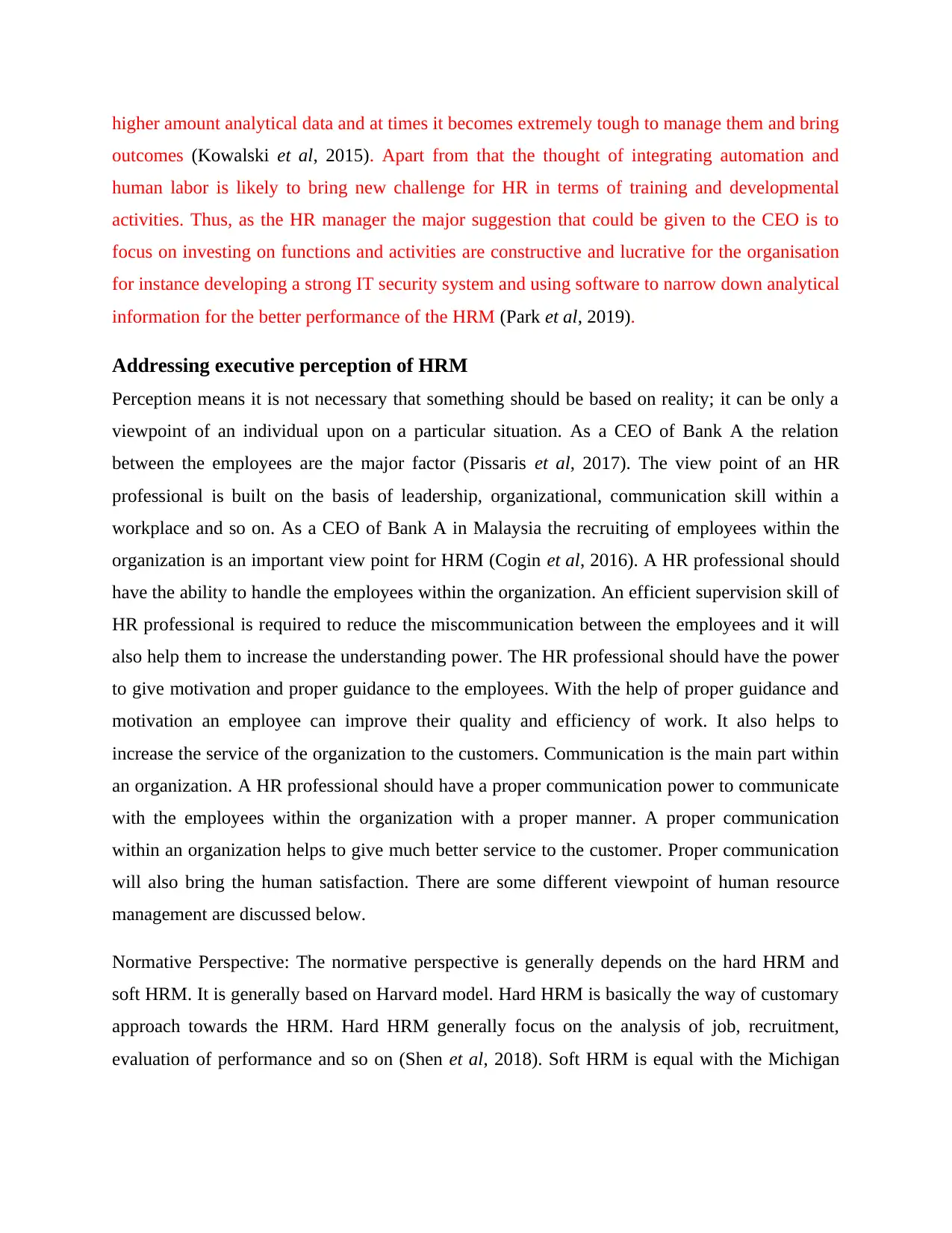
higher amount analytical data and at times it becomes extremely tough to manage them and bring
outcomes (Kowalski et al, 2015). Apart from that the thought of integrating automation and
human labor is likely to bring new challenge for HR in terms of training and developmental
activities. Thus, as the HR manager the major suggestion that could be given to the CEO is to
focus on investing on functions and activities are constructive and lucrative for the organisation
for instance developing a strong IT security system and using software to narrow down analytical
information for the better performance of the HRM (Park et al, 2019).
Addressing executive perception of HRM
Perception means it is not necessary that something should be based on reality; it can be only a
viewpoint of an individual upon on a particular situation. As a CEO of Bank A the relation
between the employees are the major factor (Pissaris et al, 2017). The view point of an HR
professional is built on the basis of leadership, organizational, communication skill within a
workplace and so on. As a CEO of Bank A in Malaysia the recruiting of employees within the
organization is an important view point for HRM (Cogin et al, 2016). A HR professional should
have the ability to handle the employees within the organization. An efficient supervision skill of
HR professional is required to reduce the miscommunication between the employees and it will
also help them to increase the understanding power. The HR professional should have the power
to give motivation and proper guidance to the employees. With the help of proper guidance and
motivation an employee can improve their quality and efficiency of work. It also helps to
increase the service of the organization to the customers. Communication is the main part within
an organization. A HR professional should have a proper communication power to communicate
with the employees within the organization with a proper manner. A proper communication
within an organization helps to give much better service to the customer. Proper communication
will also bring the human satisfaction. There are some different viewpoint of human resource
management are discussed below.
Normative Perspective: The normative perspective is generally depends on the hard HRM and
soft HRM. It is generally based on Harvard model. Hard HRM is basically the way of customary
approach towards the HRM. Hard HRM generally focus on the analysis of job, recruitment,
evaluation of performance and so on (Shen et al, 2018). Soft HRM is equal with the Michigan
outcomes (Kowalski et al, 2015). Apart from that the thought of integrating automation and
human labor is likely to bring new challenge for HR in terms of training and developmental
activities. Thus, as the HR manager the major suggestion that could be given to the CEO is to
focus on investing on functions and activities are constructive and lucrative for the organisation
for instance developing a strong IT security system and using software to narrow down analytical
information for the better performance of the HRM (Park et al, 2019).
Addressing executive perception of HRM
Perception means it is not necessary that something should be based on reality; it can be only a
viewpoint of an individual upon on a particular situation. As a CEO of Bank A the relation
between the employees are the major factor (Pissaris et al, 2017). The view point of an HR
professional is built on the basis of leadership, organizational, communication skill within a
workplace and so on. As a CEO of Bank A in Malaysia the recruiting of employees within the
organization is an important view point for HRM (Cogin et al, 2016). A HR professional should
have the ability to handle the employees within the organization. An efficient supervision skill of
HR professional is required to reduce the miscommunication between the employees and it will
also help them to increase the understanding power. The HR professional should have the power
to give motivation and proper guidance to the employees. With the help of proper guidance and
motivation an employee can improve their quality and efficiency of work. It also helps to
increase the service of the organization to the customers. Communication is the main part within
an organization. A HR professional should have a proper communication power to communicate
with the employees within the organization with a proper manner. A proper communication
within an organization helps to give much better service to the customer. Proper communication
will also bring the human satisfaction. There are some different viewpoint of human resource
management are discussed below.
Normative Perspective: The normative perspective is generally depends on the hard HRM and
soft HRM. It is generally based on Harvard model. Hard HRM is basically the way of customary
approach towards the HRM. Hard HRM generally focus on the analysis of job, recruitment,
evaluation of performance and so on (Shen et al, 2018). Soft HRM is equal with the Michigan
Paraphrase This Document
Need a fresh take? Get an instant paraphrase of this document with our AI Paraphraser
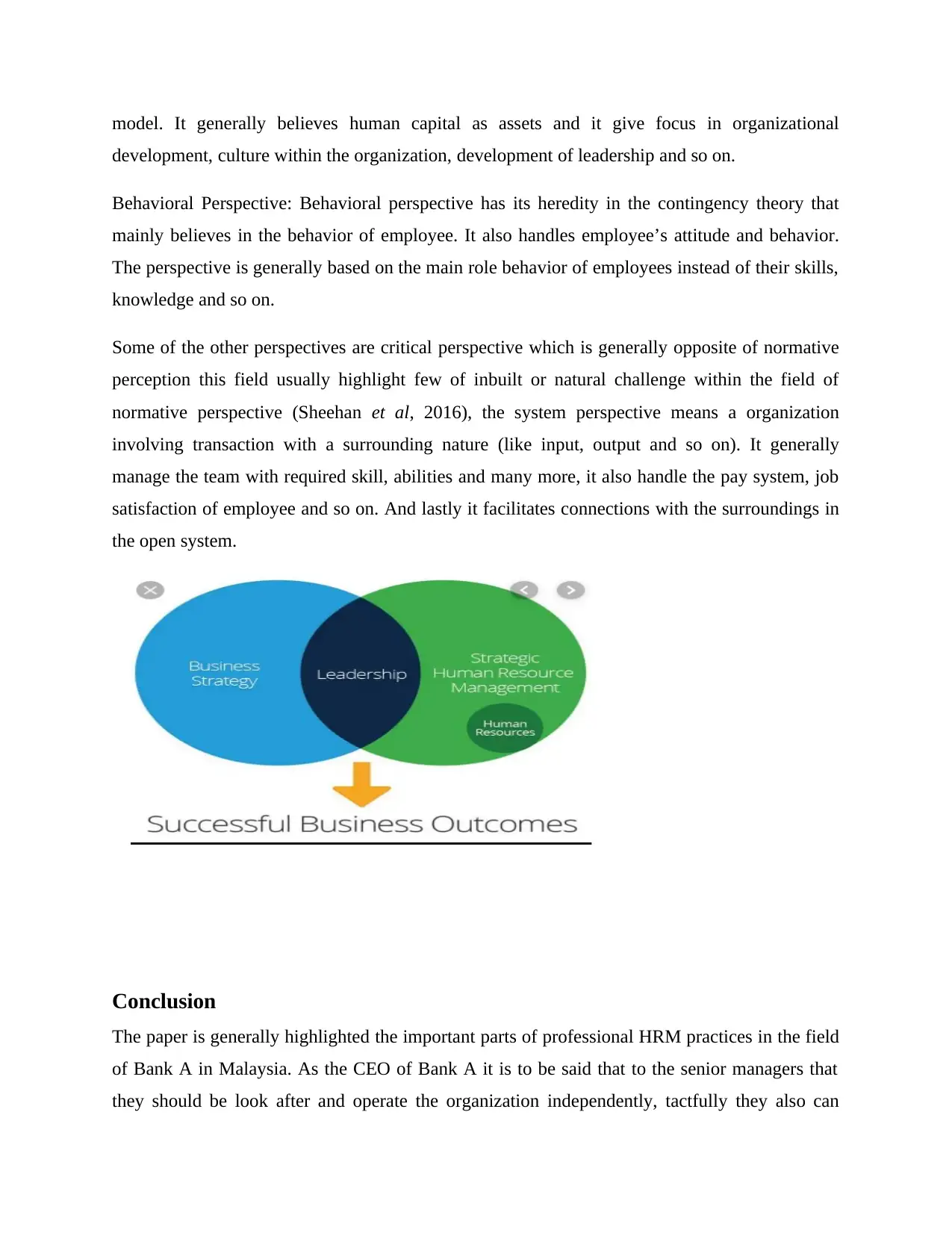
model. It generally believes human capital as assets and it give focus in organizational
development, culture within the organization, development of leadership and so on.
Behavioral Perspective: Behavioral perspective has its heredity in the contingency theory that
mainly believes in the behavior of employee. It also handles employee’s attitude and behavior.
The perspective is generally based on the main role behavior of employees instead of their skills,
knowledge and so on.
Some of the other perspectives are critical perspective which is generally opposite of normative
perception this field usually highlight few of inbuilt or natural challenge within the field of
normative perspective (Sheehan et al, 2016), the system perspective means a organization
involving transaction with a surrounding nature (like input, output and so on). It generally
manage the team with required skill, abilities and many more, it also handle the pay system, job
satisfaction of employee and so on. And lastly it facilitates connections with the surroundings in
the open system.
Conclusion
The paper is generally highlighted the important parts of professional HRM practices in the field
of Bank A in Malaysia. As the CEO of Bank A it is to be said that to the senior managers that
they should be look after and operate the organization independently, tactfully they also can
development, culture within the organization, development of leadership and so on.
Behavioral Perspective: Behavioral perspective has its heredity in the contingency theory that
mainly believes in the behavior of employee. It also handles employee’s attitude and behavior.
The perspective is generally based on the main role behavior of employees instead of their skills,
knowledge and so on.
Some of the other perspectives are critical perspective which is generally opposite of normative
perception this field usually highlight few of inbuilt or natural challenge within the field of
normative perspective (Sheehan et al, 2016), the system perspective means a organization
involving transaction with a surrounding nature (like input, output and so on). It generally
manage the team with required skill, abilities and many more, it also handle the pay system, job
satisfaction of employee and so on. And lastly it facilitates connections with the surroundings in
the open system.
Conclusion
The paper is generally highlighted the important parts of professional HRM practices in the field
of Bank A in Malaysia. As the CEO of Bank A it is to be said that to the senior managers that
they should be look after and operate the organization independently, tactfully they also can
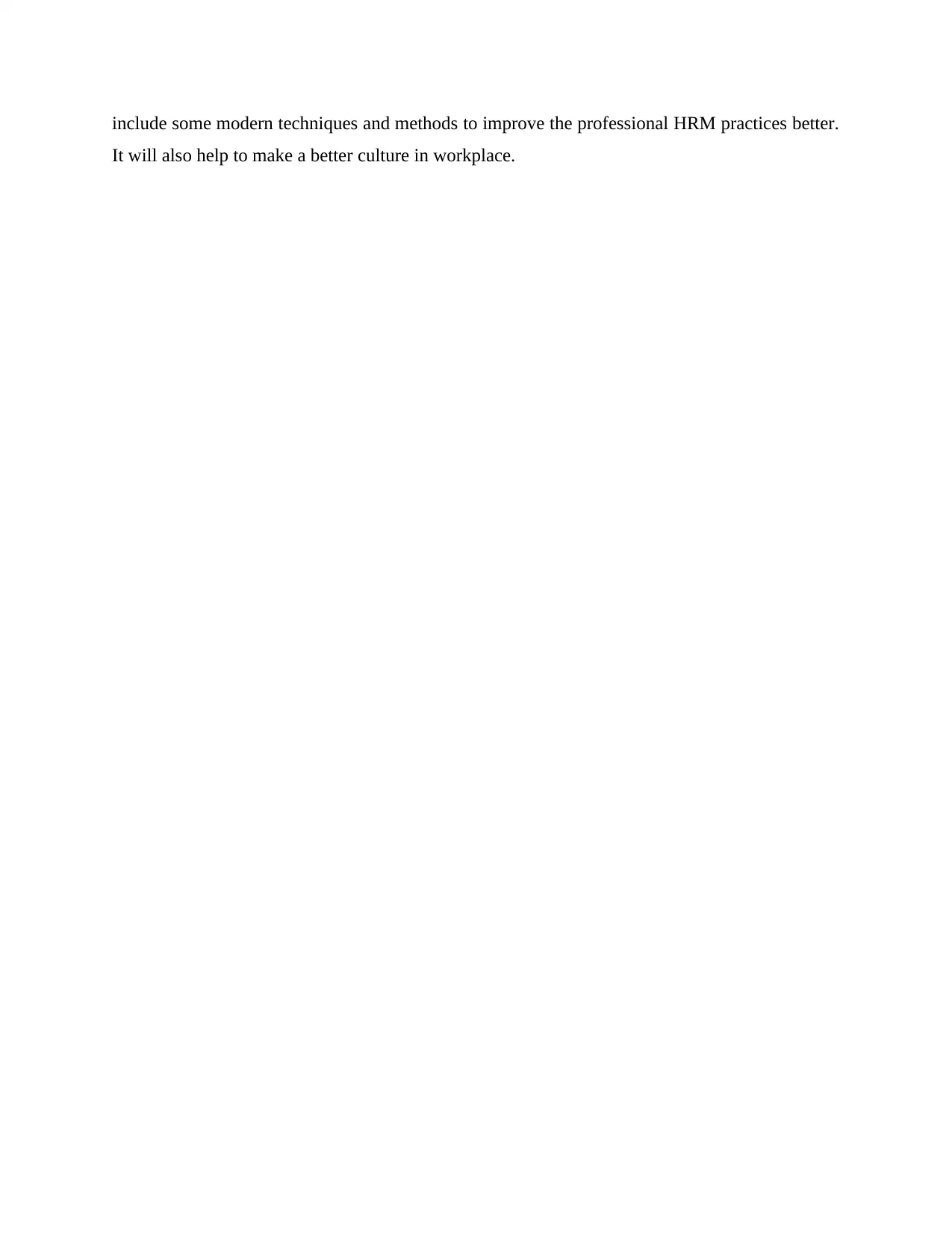
include some modern techniques and methods to improve the professional HRM practices better.
It will also help to make a better culture in workplace.
It will also help to make a better culture in workplace.
⊘ This is a preview!⊘
Do you want full access?
Subscribe today to unlock all pages.

Trusted by 1+ million students worldwide
1 out of 14
Related Documents
Your All-in-One AI-Powered Toolkit for Academic Success.
+13062052269
info@desklib.com
Available 24*7 on WhatsApp / Email
![[object Object]](/_next/static/media/star-bottom.7253800d.svg)
Unlock your academic potential
Copyright © 2020–2025 A2Z Services. All Rights Reserved. Developed and managed by ZUCOL.





